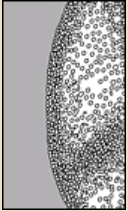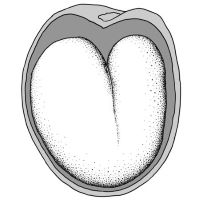Content is from Kirkbride et al. 2006Kirkbride et al. 2006:
Kirkbride JH, Jr, Gunn CR, and Dallwitz MJ. 2006. Family guide for fruits and seeds, vers. 1.0. Accessed September 2020-January 2022. URL: https://nt.ars-grin.gov/seedsfruits/keys/frsdfam/index.cfm ., without modification.
Updates are forthcoming.
Fruits: Pistil(s) compound; 1; 1-pistillate; with carpels united. Fruit pericarpium, or anthocarpanthocarp:
simple or compound and including some tissue of non-ovarian origin (accessory tissue) ; simple; drupedrupe:
; simple; drupedrupe:
(indehiscent drupe) a fleshy, indehiscent fruit with one more hard pits enclosing seeds, derived from single, superior, simple or compound ovary; (dehiscent drupe) a fruit with a dry or fibrous to fleshy or leathery outer husk that early to tardily breaks apart (or opens), exposing one or more nutlike pits enclosing the seeds , or berryberry:
, or berryberry:
an indehiscent, fleshy fruit with one or a few to many seeds. The flesh may be homogenous throughout. Or, if the outer part is hard, firm, or leathery, referred to as an hesperidium. Septa are present in some, and the seeds may be arillate or with a fleshy testa. (Aucuba, Griselinia not Spjut.); berryberry:
(Aucuba, Griselinia not Spjut.); berryberry:
an indehiscent, fleshy fruit with one or a few to many seeds. The flesh may be homogenous throughout. Or, if the outer part is hard, firm, or leathery, referred to as an hesperidium. Septa are present in some, and the seeds may be arillate or with a fleshy testa. indehiscent; berryberry:
indehiscent; berryberry:
an indehiscent, fleshy fruit with one or a few to many seeds. The flesh may be homogenous throughout. Or, if the outer part is hard, firm, or leathery, referred to as an hesperidium. Septa are present in some, and the seeds may be arillate or with a fleshy testa. without central placental mass; compound; sorosus; without persistent central column; with stylar remenant(s) (or scar); at apexapex:
without central placental mass; compound; sorosus; without persistent central column; with stylar remenant(s) (or scar); at apexapex:
the point farthest from the point of attachment, or the "tip" of an organ ; not within accessory organ(s); less than 1 cm long, or more than 10 cm long; 0.7–40 cm long; with 2–4(–5)-carpellate; without sterilesterile:
; not within accessory organ(s); less than 1 cm long, or more than 10 cm long; 0.7–40 cm long; with 2–4(–5)-carpellate; without sterilesterile:
lacking male and/or female reproductive parts; also, not producing fruit or seed
 carpels; apexapex:
carpels; apexapex:
the point farthest from the point of attachment, or the "tip" of an organ not beaked; wall fleshy; indehiscentindehiscent:
not beaked; wall fleshy; indehiscentindehiscent:
not opening on its own, as in a fruit
 . Epicarpepicarp:
. Epicarpepicarp:
outer layer of fruit wall or pericarp, if divided into layers; note here used synonymously with exocarp green, or purple (with or without corkycorky:
green, or purple (with or without corkycorky:
firm, relatively light, discontinuous but strongly cohesive, and resilient
spots), or red, or yellow; durable; hard (Davidia); glabrousglabrous:
without hairs
; without armature; smooth; without wing(s); without apicalapical:
at or pertaining to the end of the seed or fruit distal from its point of attachment (i.e., base)
respiratory hole. Mesocarpmesocarp:
the middle layer of the pericarp, if divided into layers present; fleshy, or granulargranular:
present; fleshy, or granulargranular:
surface relief—having a grainy surface ; composed of 1 unified layer; without lactiform cavity system; & endocarpendocarp:
; composed of 1 unified layer; without lactiform cavity system; & endocarpendocarp:
the inner layer of the pericarp, if divided into layers sharply differentiated. Endocarpendocarp:
sharply differentiated. Endocarpendocarp:
the inner layer of the pericarp, if divided into layers present, or absent; not separating from exocarpexocarp:
present, or absent; not separating from exocarpexocarp:
outer layer of fruit wall or pericarp, if divided into layers; note here used synonymously with epicarp ; bonybony:
; bonybony:
very hard and rather brittle, like bone
, or woodywoody:
texture—consisting mainly of indurate lignified tissues, characteristic of or resembling wood
, or chartaceouschartaceous:
papery, papyraceous
(Camptotheca); not splitting into 1-seeded pyrenespyrene:
the hard inner portion of a drupe, consisting of a bony endocarp and an enclosed seed
, or splitting into 1-seeded pyrenes; stone unilocular, or plurilocular; stone 1–2-loculate; not smooth, or smooth; with ridges (usually 12 & some sharp & some winged), or furrow(s) (apexapex:
the point farthest from the point of attachment, or the "tip" of an organ to base), or knobs; without wing, or with wing; with operculumoperculum:
to base), or knobs; without wing, or with wing; with operculumoperculum:
a dehiscent cap (or lid) of a seed or fruit that opens during germination or dehiscence , or without operculumoperculum:
, or without operculumoperculum:
a dehiscent cap (or lid) of a seed or fruit that opens during germination or dehiscence ; 2-operculate; without secretory cavities; without mechanism for seedling escape, or with mechanism for seedling escape (in former Nyssaceae genera each loculelocule:
; 2-operculate; without secretory cavities; without mechanism for seedling escape, or with mechanism for seedling escape (in former Nyssaceae genera each loculelocule:
structurally distinct compartment with the fruit
opening apically by a triangulartriangular:
2D shape—three relatively straight sides with distinct corners; more angular than teardrop-shaped abaxialabaxial:
abaxialabaxial:
dorsal; on the side that is away from the axis (in nutlets, the side facing outwards); (compare adaxial) valve at germination); with grooves, or without grooves; with longitudinallongitudinal:
valve at germination); with grooves, or without grooves; with longitudinallongitudinal:
of or relating to length or the lengthwise dimension
ridges, or without longitudinallongitudinal:
of or relating to length or the lengthwise dimension
ridges; without fracturing longitudinallongitudinal:
of or relating to length or the lengthwise dimension
ridges. Funiculusfuniculus:
(alt. funicle) stalk connecting the ovule (later seed) to the ovary (later fruit) placenta short; short without seed bearing hookswith hooks:
short; short without seed bearing hookswith hooks:
bristles or spines with curved or backwards pointing tips, or with secondary bristles along their length (retinacula); not persisting in fruit after seed shed.
(retinacula); not persisting in fruit after seed shed.
Seeds: Arilaril:
(broad sense) appendicular structure that wholly or partly envelops a seed and is produced from or a modification of the funicle, raphe, or outer integument; usually fleshy or pulpy, sometimes spongy or tufted-capillate, often brightly colored absent. Seed larger than minute; straight, or D-shapedD-shaped:
absent. Seed larger than minute; straight, or D-shapedD-shaped:
2D shape—has one straight margin and one curved margin, resembling the shape of the letter D
, or circularcircular:
(of embryo) linear embryo is curved into an "O" shape ; in transection compressedcompressed:
; in transection compressedcompressed:
flattened; in grasses, used to denote compression (not necessarily flattened) either laterally or dorsiventrally
, or tereteterete:
approximately circular in cross section; width and thickness approximately equal
 ; not bowl shaped; not nutlike; without winglike beakbeak:
; not bowl shaped; not nutlike; without winglike beakbeak:
a usually firm, terminal appendage, sometimes tapered ; without caudatecaudate:
; without caudatecaudate:
tapering to a long, tail-like appendage appendage(s); at maturity with food reserves; with endosperm; without canavanine. Sarcotestasarcotesta:
appendage(s); at maturity with food reserves; with endosperm; without canavanine. Sarcotestasarcotesta:
pulpy or fleshy outer layer of the seed coat, simulates aril absent. Testatesta:
absent. Testatesta:
seed coat
 present; without fleshy or leatheryleathery:
present; without fleshy or leatheryleathery:
texture—moderately thick, tough, and very pliable
layer over hard layer; tight; surface smooth (assumed); without crease or line separating cotyledons from hypocotyl-radicle; without notch along margin where cotyledons from hypocotyl-radicle tip approach each other; without glands; without bristles; glabrousglabrous:
without hairs
; without wings; without collar; without operculumoperculum:
a dehiscent cap (or lid) of a seed or fruit that opens during germination or dehiscence ; colored; monochrome; brown (all shades); coriaceouscoriaceous:
; colored; monochrome; brown (all shades); coriaceouscoriaceous:
texture—leathery
; not becoming mucilaginousmucilaginous:
resembling mucilage; moist and sticky
when wetted; surrounding food reserve. Endosperm development cellular; copious to scant; fleshy; smooth; with oils, or hemicellulose (occasionally); without fatty acid containing cyclopropene; with petroselenic acid (Aucuba); without apicalapical:
at or pertaining to the end of the seed or fruit distal from its point of attachment (i.e., base)
lobes; without chlorophyll; without isodiametric faceted surface; without odor. Embryo differentiated from food reserve; well developed; 1 per seed; partially filling testatesta:
seed coat
 (with food reserve); 0.7–1 times the length of food reserve; at one end of seed not extending into a depression or cup; axileaxile:
(with food reserve); 0.7–1 times the length of food reserve; at one end of seed not extending into a depression or cup; axileaxile:
on or of the axis
and centric; foliatefoliate:
appearing leaf-like
, or linearlinear:
(shape) long, narrow, and uniform in width; (of embryo) embryo is straight and much longer than wide (occasionally); with spatulatespatulate:
(occasionally); with spatulatespatulate:
2D shape—like a spatula; rounded at the apex, with base long and tapered; (of embryo) embryo is straight and axile and centric with the cotyledons expanded to form the shape of a spatula or spoon; (of cotyledons) cotyledons expanded and wider than the stalk but not invested into the stalk cotyledons; straight, or bentbent:
cotyledons; straight, or bentbent:
(of embryo) embryo is bent at an acute, V-shaped angle with the ends close together and generally thick cotyledons ; more or less parallel to seed length; with cotyledons abruptly connected to hypocotyl-radicle; without coleorhiza; without simmondsin; without stomata; not green; with 2 or more cotyledons. Cotyledons 2; well developed, or moderately developed; 0.3–0.9 times length of embryo; somewhat to significantly wider than hypocotyl-radicle, or as wide as hypocotyl-radicle; 1–4.7 times wider than hypocotyl-radicle; not concealing hypocotyl-radicle; not foliaceous; thick, or thin; flat; with apicesapex:
; more or less parallel to seed length; with cotyledons abruptly connected to hypocotyl-radicle; without coleorhiza; without simmondsin; without stomata; not green; with 2 or more cotyledons. Cotyledons 2; well developed, or moderately developed; 0.3–0.9 times length of embryo; somewhat to significantly wider than hypocotyl-radicle, or as wide as hypocotyl-radicle; 1–4.7 times wider than hypocotyl-radicle; not concealing hypocotyl-radicle; not foliaceous; thick, or thin; flat; with apicesapex:
the point farthest from the point of attachment, or the "tip" of an organ entire, or notched; with margins separate; basally entire; equal in size; not punctatepunctate:
entire, or notched; with margins separate; basally entire; equal in size; not punctatepunctate:
surface relief—dotted with pits or with translucent, sunken glands or with colored dots, similar to pitted dotted. Hypocotyl-radicle well developed; straight; not thickened.
dotted. Hypocotyl-radicle well developed; straight; not thickened.
Literature specific to this family: Eyde, R.H. 1963. Morphology and paleobotanical studies of the Nyssaceae. I. A survey of the modern species and their fruits. J. Arnold Arbor. 44:1–59; Eyde, R.H. 1966. Systematic anatomy of the flower and fruit of Corokia. Amer. J. Bot. 53:833–847.
General references: Boerlage, J. G. 1897–1914. Icones Borgorienses, 4 vols. E.J. Brill, Leiden (plate numbers are in [ ]), Cronquist, A. 1981. An integrated system of classification of flowering plants, 1,262 p. Columbia University Press, New York, Engler, A. & K. Prantl. 1924 and onward. Die Natürlichen Pflanzenfamilimien. W. Engelman, Leipzig, Gaertner, J. 1788–1805. De fructibus et seminibus plantarum. The Author, Stuttgart, Goldberg, A. 1986 (dicots) & 1989 (monocots). Classification, evolution, and phylogeny of the familes of Dicotyledons. Smithsonian Contr. Bot. 58 for dicots (314 pp.) & 71 for monocots (74 pp.). [Goldberg's illustrations are reproduced from older publications and these should be consulted], Gunn, C.R., J.H. Wiersema, C.A. Ritchie, & J.H. Kirkbride, Jr. 1992 & amendments. Families and genera of Spermatophytes recognized by the Agricultural Research Service. Techn. Bull. U.S.D.A. 1796:1–500, Hooker, J.D. 1873 and forward. Icones Plantarum. William & Norgate, London. (plate number cited in text within [ ]), Mabberley, D.J. 1987. The plant-book, 706 p. Cambridge University Press, Cambridge, Martin, A.C. 1946. The comparative internal morphology of seeds. Amer. Midl. Naturalist 36:513–660, Schopmeyer, C.S. 1974. Seeds of Woodywoody:
texture—consisting mainly of indurate lignified tissues, characteristic of or resembling wood
plants in the United States. Agric. Handb. 450:1–883, Spjut, R.W. 1994. A systematic treatment of fruit types. Mem. New York Bot. Gard. 70:1–182, and Wood, C.E., Jr. 1974. A student's atlas of flowering plants: Some dicotyledons of eastern North America, 120 pp. Harper & Row, New York.